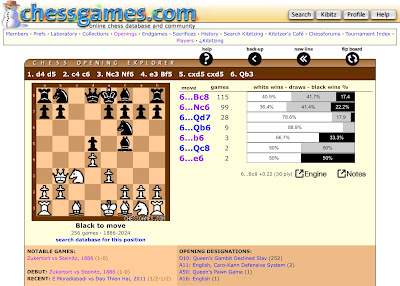Although this position, like those from Paul Morphy’s games that I looked at yesterday, is one I’ve examined in previous partial readings of Thomas Engqvist’s book, today it raised questions that kept me hunting for more.
The position arose after Black on move 4 brings the bishop to f5, “(too) early”, Willy Hendriks wrote in The Ink War: Romanticism versus Modernity in Chess (2022), 338. Hendricks speculates that William Steinitz may have expected 5.c5, similar to game one via a different move order. But Johannes Zukertort sought to punish the inaccuracy with 5.cxd5 and Steinitz soon brought the bishop back to its starting square.
As late as 2011, Cyrus Lakdawala in The Slav: Move by Move asserted that 4…Bf5, the Reversed London, was unplayable after 1.d4 d5 2.c4 c6 3.Nc3 Nf6 4.e3 because of the problems Black faced in Zukertort — Steinitz, New York 1886, the fifth game of the first official world championship. Lakdawala notes, "Black experiences difficulties defending both b7 and d5." He offers four options and concludes that 6...Bc8 is best.
But, no less than three high level games were played in 2012 with a move that Lakdawala did not mention. With this “revolutionary improvement” that Engqvist presents vie Wojtaszek — Wang Yue, White’s queen snatches a pawn and then gets driven back to its starting square. “Black has good compensation since he is ahead in development and has seized the initiative” (16).While taking the first sip of yesterday’s microwaved coffee (before the fresh pot of French press was ready), I decided correctly on Black’s initial move from the position, but then found the errors in the first line that I considered to chase the queen back. In both the line I began with and the one played by Wang Yue and other masters, the bishop retreats from f5.
5.cxd5 cxd5 6.Qb3
Position 6 in Engqvist
6…Nc6!
This move is the improvement over the old main line, 6…Bc8.
7.Qxb7 Bd7
7…Na5, which I considered first, has not been played, but not by masters. I saw 8.Bb5+ Bd7 9.Bxd7+ Nxd7 10.Qxd5 and it is clear that dropping two pawns was not Black’s idea.
8.Qb3 Rb8 9.Qd1 e5!
White to move
This is where Engqvist’s analysis ends. I could have stopped there, but the sequence leading to the position first grabbed my interest, then the lines played prior to 2012 sent me searching through books and databases. During two hours, I explored the opening tree and several games on chessgames.com, utilized the ChessBase iPad app, and then turned on my computer where I have three ebooks on the Slav Defense resident within ChessBase.
I looked at several games with the bishop retreating to c8. I explored move order nuances reaching the initial position. There is much to learn even though the basic concept Engqvist wants the reader to see is simple: through a somewhat logical developing move in what seems a difficult position, Black sacrificed a pawn for the initiative.
Wojtaszek — Wang Yue was played in October 2012. In May, Sabino Brunello was the first to play Black’s idea. In the Italian Team Championship, Black got a lasting initiative and prevailed through a tactical melee against Csaba Horvath. John Shaw also played Black’s idea in August at the Istanbul Olympiad against Luc Winants. Wang Yue was at that event.
The other four positions that I hope to examine today are all among those I have examined in the past. I recall that one or two of the others have also sent me down some rabbit holes. There is wisdomn in Engqvist's suggestion that the reader study five positions per week, rather than race through the book the way I am struggling to achieve.
I looked at several games with the bishop retreating to c8. I explored move order nuances reaching the initial position. There is much to learn even though the basic concept Engqvist wants the reader to see is simple: through a somewhat logical developing move in what seems a difficult position, Black sacrificed a pawn for the initiative.
Wojtaszek — Wang Yue was played in October 2012. In May, Sabino Brunello was the first to play Black’s idea. In the Italian Team Championship, Black got a lasting initiative and prevailed through a tactical melee against Csaba Horvath. John Shaw also played Black’s idea in August at the Istanbul Olympiad against Luc Winants. Wang Yue was at that event.
The other four positions that I hope to examine today are all among those I have examined in the past. I recall that one or two of the others have also sent me down some rabbit holes. There is wisdomn in Engqvist's suggestion that the reader study five positions per week, rather than race through the book the way I am struggling to achieve.














No comments:
Post a Comment